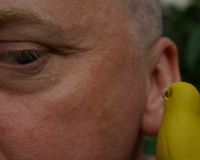Posted on Thu 26 May 2016
Uncommon Coding Theory and the Phenomenological Bump
Common coding theory is a cognitive psychology theory describing how perceptual representations (e.g. of things we can see and hear) and motor representations (e.g. of hand actions) are linked. The theory claims that there is a shared representation (a common code) for both perception and action.

Posted by
Project

Magician in Residence: Stuart Nolan
Meet Stuart Nolan's new pet the IdeoBird, a magical, mindreading creature. Held gently in your palm, the IdeoBird can sense the small subconscious movements of your hand and arms and so divine your secrets.Common coding theory is a cognitive psychology theory describing how perceptual representations (e.g. of things we can see and hear) and motor representations (e.g. of hand actions) are linked. The theory claims that there is a shared representation (a common code) for both perception and action. More important, seeing an event activates the action associated with that event, and performing an action activates the associated perceptual event.
As I have mentioned in a previous post, Common Coding Theory suggests that that the same neurological processes will deal with Doing Something, Thinking About Doing That Thing, and Watching Someone Else Do That Thing. You will get the same physical response in each of these instances.
But what happens when we watch something that becomes impossible. If we watch a visual magic effect the actions accociated with the event are triggered - our bodies, on some level, are resonating with the actions of the magician. Until the moment what something impossible is done. Then our bodies cannot resonate, Common Coding can find no common ground, what we feel is Uncommon both because there is not Common Coding and because it feels strange. We often feel a physical reaction to this monent. Audiences gasp, jump, back away, and feel the ground shift beneath them.
I call this moment when Common Coding becomes Uncommon a Phenomenological Bump. I feel it goes some way to explaining why we get such a visceral reaction to some kinds of visual magic effects.
This week we've been tying in this theory of mine with Resonance Based Interfaces and Alva Noe's Enactive Theory of Consciousness. Unsure where this theory will lead us in practice as yet but it's good to be discussing things at this level as well as wrangling the tech.
